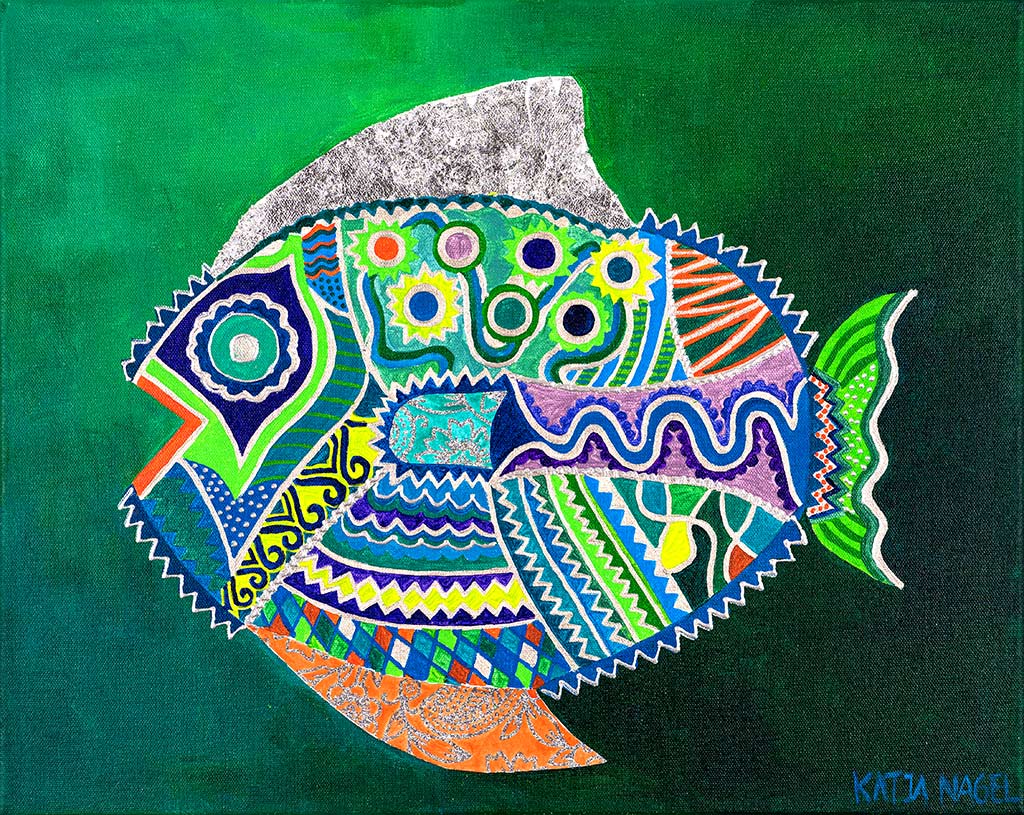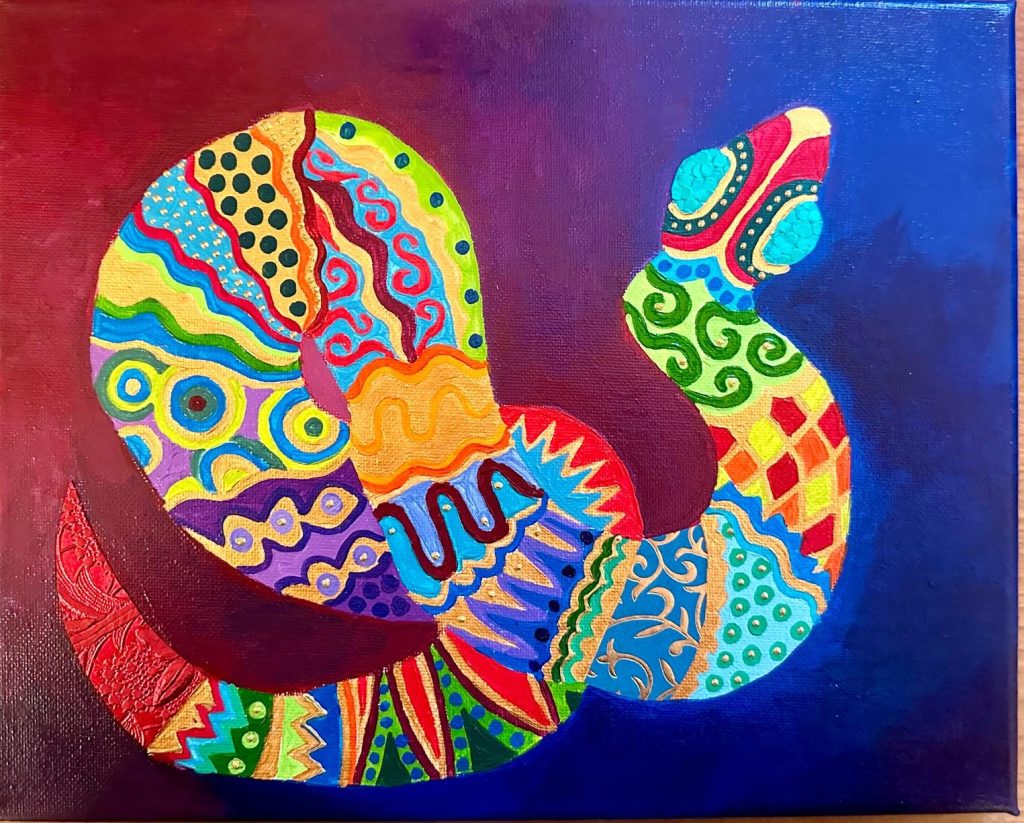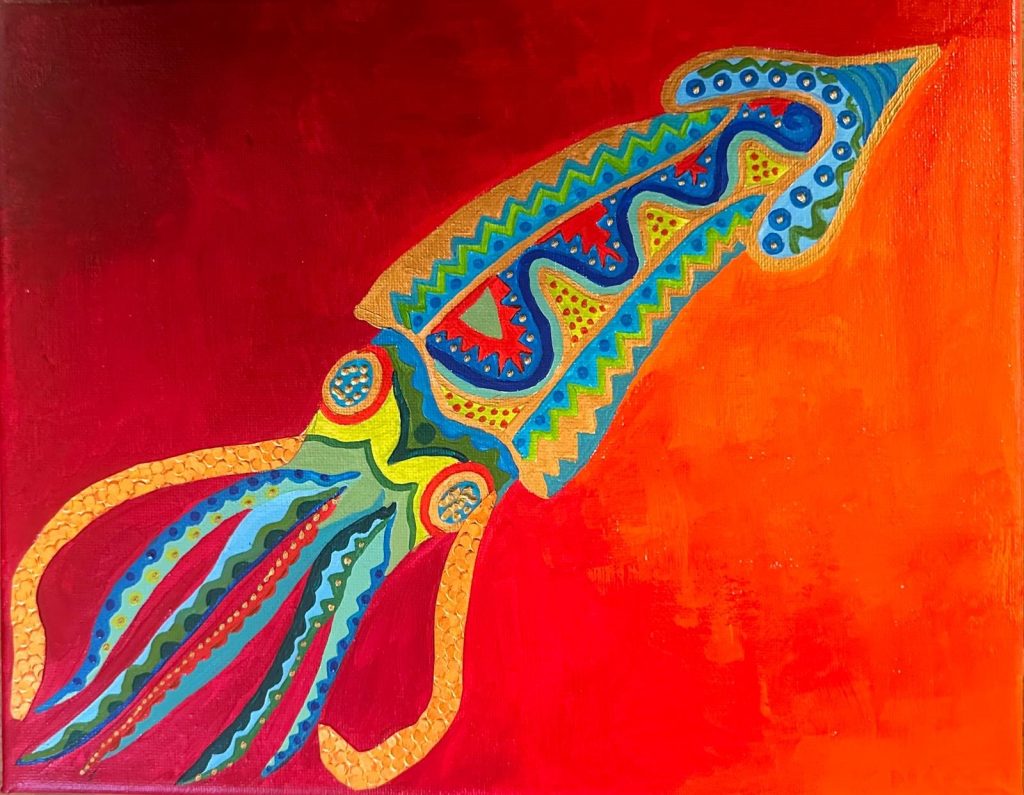



HERE YOU WILL FIND
A SELECTION OF MY WORKS
KATJA NAGEL ARTS

Thetis as fire, water, lion, snake and octopus
(50×100 CM)
In Greek mythology, Hippocampus (sea horse) is the name of a mythical creature – half horse, half fish. It is the draught and riding animal of various sea gods. The front part sometimes has wings, the rear fish part with dorsal fin is often curled up like a snake. Seahorses are the descendants of those steeds that pulled Poseidon‘s chariot.
No comments found


Thetis in resistance
(100×50 CM)
In Greek mythology, Thetis turns into fire and into water, into a lion and into a snake and finally into an octopus in order to elude Peleus. Peleus continued to hold her all the while, even though he was burned, drenched, scratched, bitten and splashed with ink.
No comments found


Psari 1 blue
Trilogy (50×40 CM)
Pisces is one of the 48 constellations that Ptolemy had already described in ancient Greek astronomy. The constellation gave its name to the astrological sign of the zodiac. Around 2,000 years ago, the vernal equinox changed to the astrological sign of Pisces.
No comments found


Psari 2 teal
Trilogy (50×40 CM)
Pisces is one of the 48 constellations that Ptolemy had already described in ancient Greek astronomy. The constellation gave its name to the astrological sign of the zodiac. Around 2,000 years ago, the vernal equinox changed to the astrological sign of Pisces.
No comments found


Psari 3 Green
Trilogy (50×40 CM)
Pisces is one of the 48 constellations that Ptolemy had already described in ancient Greek astronomy. The constellation gave its name to the astrological sign of the zodiac. Around 2,000 years ago, the vernal equinox changed to the astrological sign of Pisces.
No comments found


Thalassa Collection
(150×120 CM)
Thalassa is the embodiment of the sea in Greek mythology. After the union with Pontos, she gave birth to all life in the seas and thus becomes the mother of fish.
No comments found


Thetis before the battle
Striptych 3 X (30×30 CM)
In Greek mythology, Thetis transforms herself into an octopus to elude Peleus.
No comments found


Cassiopea jellyfish
(160×140 cm)
In Greek mythology, the Cassiopea jellyfish is dedicated to Cassiopeia, the mother of Andromeda. In terms of phylogeny, jellyfish are among the oldest living creatures of all, they can be traced back 670 million years to the Precambrian. In antiquity, Aristotle was interested in them, and among the hundred or so sea creatures he described, he named them cnidae, which means „stinging“. There are about 100 species of jellyfish in the Mediterranean.
No comments found


Lobster of the Acheloos
(60×40 cm)
In some mythologies, lobsters are considered sacred and are said to bring luck, happiness and prosperity. In Greek mythology, lobsters were associated with the goddess Aphrodite, the goddess of love and beauty. The river god Acheloos is also said to have worn a mask with lobster claws and antennae.
No comments found


Snake of the Asclepius Staff
10 x (10×10 cm)
In Greek mythology, the snake was considered the protector of the underworld, symbolising the religious connection with the depths of the earth. Its flaying stood for rebirth, eternal youth and immortality. The staff of Asclepius is a staff entwined with a snake, attribute of Asclepius, the god of healing.
No comments found


Nymph Scylla
(75×105 cm)
In Greek mythology, Scylla is a nymph transformed into a sea monster by the sorceress Circe. Together with Charybdis, who can transform into a whirlwind, they guard the Strait of Messina between Italy and Sicily, and the Odyssey tells how they almost swallowed the legendary Greek hero Odysseus.
No comments found


Chelone 1 in Distress
Trilogy (50×40 cm)
In Greek mythology, Chelone is a virgin who was turned into a turtle by Hermes, the messenger of the gods, after she stayed away from the wedding of Hera and Zeus.
No comments found


Chelone 2 in its beauty
Trilogy (50×40 cm)
In Greek mythology, Chelone is a virgin who was turned into a turtle by Hermes, the messenger of the gods, after she stayed away from the wedding of Hera and Zeus.
No comments found


Chelone 3 on the way back
Trilogy
(50×40 cm)
In Greek mythology, Chelone is a virgin who was turned into a turtle by Hermes, the messenger of the gods, after she stayed away from the wedding of Hera and Zeus.
No comments found


Skylla (Excerpt)
Triptych
3 x (30×30 cm)
In Greek mythology, Scylla is a nymph transformed into a sea monster by the sorceress Circe. Together with Charybdis, who can transform into a whirlwind, they guard the Strait of Messina between Italy and Sicily, and the Odyssey tells how they almost swallowed the legendary Greek hero Odysseus. Excerpt 3 tentacles in motion.
No comments found


The Sardines of Ptolemy
Triptych
3 x (40×60 cm)
Sardines live in shallow, open water areas near the coast. The shoals migrate between different water depths in a daily rhythm. Pisces belong to the 48 constellations of ancient Greek astronomy, which were already described by Ptolemy. He was a Greek mathematician, geographer, astronomer, astrologer, music theorist and philosopher. In particular, his three works on astronomy, geography and astrology were considered standard scientific works in Europe until the early modern era.
No comments found


The Red Barbs of Ptolemy
Triptych
3 x (30×30 cm)
Red mullets are usually found in large schools close together over soft, sandy and muddy grounds. Pisces are also one of the 48 constellations of ancient Greek astronomy, already described by Ptolemy. He was a Greek mathematician, geographer, astronomer, astrologer, music theorist and philosopher. In particular, his three works on astronomy, geography and astrology were considered standard scientific works in Europe until the early modern era.
No comments found


The Fishes of Ptolemy
Triptych
3 x (40×60 cm)
Diversity in the sea. Pisces is one of the 48 constellations of ancient Greek astronomy, already described by Ptolemy. He was a Greek mathematician, geographer, astronomer, astrologer, music theorist and philosopher. In particular, his three works on astronomy, geography and astrology were considered standard scientific works in Europe until the early modern era.
No comments found


Serpent of Hades
2 x (20×30 cm)
In Greek mythology, the serpent was considered the protector of the underworld, Hades, and symbolized the religious connection with the depths of the earth. Its moulting stood for rebirth, eternal youth and immortality.
No comments found


Artfremde Metamorphose
(30×40 cm)
Metamorphose (griechisches Wort) beschreibt die Verwandlung eines Tieres im Zeitverlauf oder eine Art in der Anpassung an sich wandelnde Umstände. Oder die Verwandlung von Göttern und Menschen in Tiere in der griechischen Mythologie.
No comments found


Mosaik 1
(20×30 cm)
Als Teil eines Gesamtmosaiks vorgesehen, das individuell zusammengestellt werden kann.
No comments found


Mosaik 2
(20×30 cm)
Als Teil eines Gesamtmosaiks vorgesehen, das individuell zusammengestellt werden kann.
No comments found


Mosaik 3
(20×30 cm)
Als Teil eines Gesamtmosaiks vorgesehen, das individuell zusammengestellt werden kann.
No comments found


Mosaik 4
(20×30 cm)
Als Teil eines Gesamtmosaiks vorgesehen, das individuell zusammengestellt werden kann.
No comments found


Mosaik 5
(20×30 cm)
Als Teil eines Gesamtmosaiks vorgesehen, das individuell zusammengestellt werden kann.
No comments found


Mosaik 6
(20×30 cm)
Als Teil eines Gesamtmosaiks vorgesehen, das individuell zusammengestellt werden kann.
No comments found


Mosaik 7
(20×30 cm)
Als Teil eines Gesamtmosaiks vorgesehen, das individuell zusammengestellt werden kann.
No comments found


Mosaik 8
(20×30 cm)
Als Teil eines Gesamtmosaiks vorgesehen, das individuell zusammengestellt werden kann.
No comments found


Mosaik 9
(20×30 cm)
Als Teil eines Gesamtmosaiks vorgesehen, das individuell zusammengestellt werden kann.
No comments found


Mosaik 10
(20×30 cm)
Als Teil eines Gesamtmosaiks vorgesehen, das individuell zusammengestellt werden kann.
No comments found


Mosaik 11
(20×30 cm)
Als Teil eines Gesamtmosaiks vorgesehen, das individuell zusammengestellt werden kann.
No comments found


Mosaik 12
(20×30 cm)
Als Teil eines Gesamtmosaiks vorgesehen, das individuell zusammengestellt werden kann.
No comments found


Mosaik Gesamtwerk Beispiel
(je 20×30 cm)
Gesamtmosaik, das individuell zusammengestellt werden kann.
No comments found





No comments found